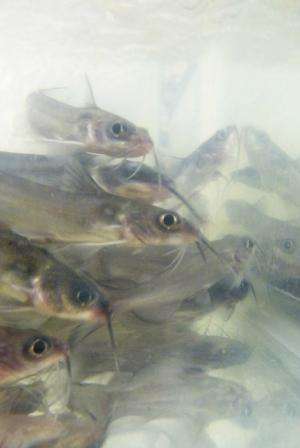Using clay to fight fish disease

A type of clay used in cosmetics, medicine, and papermaking may be just what aquaculture farmers need to fight columnaris—a costly and deadly bacterial disease that affects freshwater finfish worldwide.
Agricultural Research Service scientists have discovered that adding this clay, called "kaolin," to water significantly improves the survival rate of channel catfish with columnaris disease, which is caused by the bacterial pathogen Flavobacterium columnare. Columnaris affects many commercially grown fish species, but few preventive methods or therapies are available to treat it, says Benjamin Beck, a fish physiologist at ARS's Harry K. Dupree Stuttgart [Arkansas] National Aquaculture Research Center.
"The pathogen is ubiquitous. It's everywhere," Beck says. "It's even found on healthy fish at very low levels, but doesn't usually cause a problem until they become stressed."
The disease primarily affects the gills, skin, and fins of fish. The bacteria are proteolytic (producing tissue-degrading enzymes), and "in severe cases, the infection can expose underlying muscle," Beck adds. "Fish can lose their entire fins, but the real target is the gill. If the fish loses gill function, it quickly dies, because the gills act to exchange gases—similar to our lungs."
Beck and his ARS colleagues evaluated kaolin as an alternative to antibiotics, which are sometimes used to treat disease in fish. While the United States is one of the leading producers of kaolin, it is found globally. The soft white clay is also used in the manufacture of china, porcelain, and other products.
ARS scientists collaborated with researchers at KaMin, LLC, in Macon, Georgia, who supplied the kaolin and helped formulate different sizes of clay particles to use in the study. Experiments consisted of adding kaolin to tanks of water that contained young catfish—called "fingerlings"—while some tanks received no treatment. The disease-causing pathogen was then added to the water of all tanks.
"We chose to test fingerlings, which are about 3 to 5 inches in size, because many problems with columnaris occur during this phase of production," Beck says. "Fingerling sales are a very important market for the catfish industry."
During the 7-day study period, survival rates were 96 percent for kaolin-treated fish and 79 percent for untreated fish. Microscopic analysis of untreated fish revealed severe lesions on the gills, whereas gills of fish exposed to clay had no lesions.
"We discovered how the kaolin works," Beck says. "It 'grabs' the bacterium and binds to it, thereby preventing it from attaching to the fish and causing the disease."
Scientists believe that the process can be scaled up for commercial production. "We may be able to make a filter that contains kaolin, which can be used to reduce pathogen loads in the water," Beck says.
"One thing that makes this clay ideal is that it is inexpensive," he adds. "I can't quote a price, but compared to an antibiotic, it's reasonably priced."
Provided by Agricultural Research Service


















